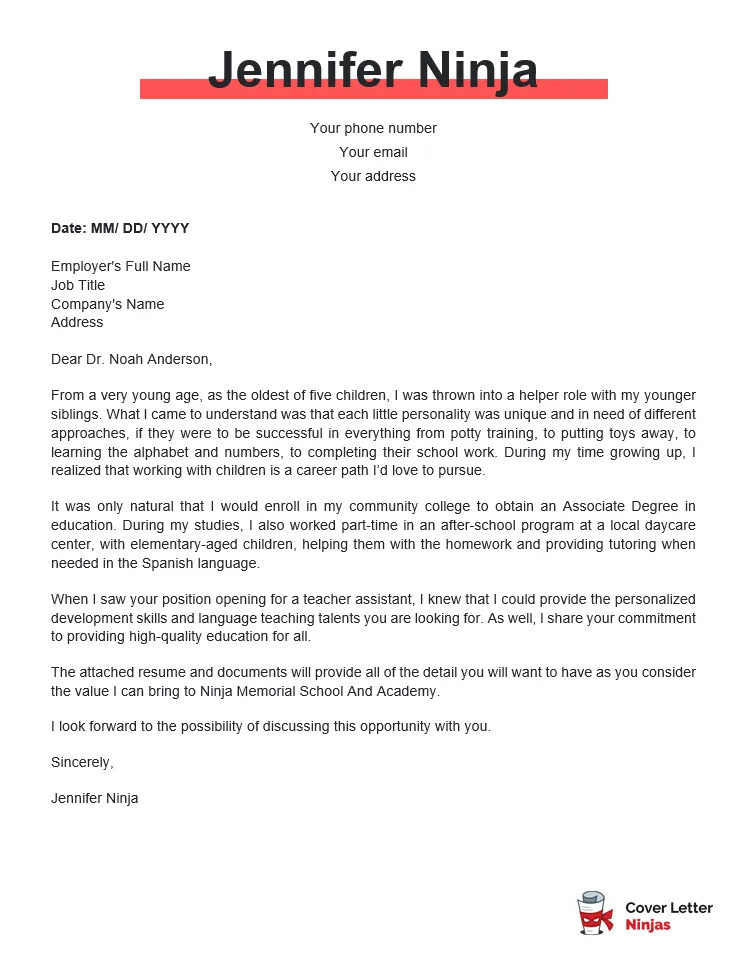Crafting Your Assistant Teacher Cover Letter
A well-crafted cover letter is a crucial first step in securing an assistant teacher position. It serves as your initial introduction to a potential employer, providing an opportunity to showcase your qualifications, skills, and enthusiasm for the role. This ultimate guide will walk you through every step of creating a compelling cover letter that grabs attention and increases your chances of landing an interview. From understanding the purpose of a cover letter to highlighting your experience and formatting the document correctly, this guide equips you with the knowledge and tools necessary to make a positive first impression. Remember that your cover letter is a reflection of your professionalism and attention to detail, so taking the time to craft a polished and personalized document is time well spent.
Understanding the Purpose of a Cover Letter
The primary purpose of a cover letter is to introduce yourself to the hiring manager and express your interest in a specific position. Unlike a resume, which provides a factual overview of your qualifications, a cover letter allows you to explain why you are the ideal candidate and how your skills align with the needs of the school or educational institution. It provides a platform to showcase your personality, communication skills, and passion for teaching. A well-written cover letter can highlight key experiences and achievements that might not be fully detailed in your resume, giving the hiring manager a deeper understanding of your capabilities and potential as an assistant teacher. Furthermore, it offers an opportunity to demonstrate your understanding of the school’s mission, values, and the specific requirements of the role.
Highlighting Your Skills and Qualifications
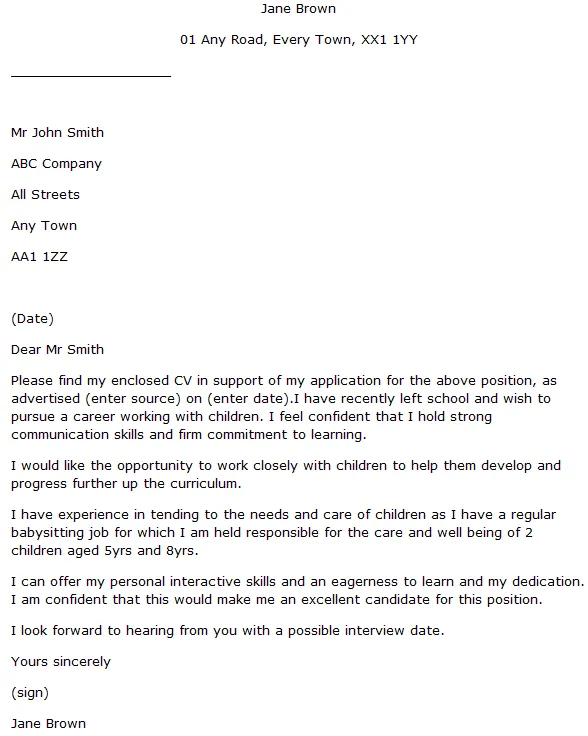
In your cover letter, it is essential to highlight the skills and qualifications that make you a strong candidate for an assistant teacher position. Start by carefully reviewing the job description and identifying the key skills and requirements listed. Then, select the most relevant skills and provide specific examples of how you have demonstrated them in the past. Focus on skills such as classroom management, communication, organization, and collaboration. Clearly articulate how your qualifications meet the needs of the school or educational institution. This could include any relevant certifications, educational background, or specialized training. Quantify your achievements whenever possible to demonstrate the impact you have made in previous roles.
Relevant Skills for Assistant Teachers
Assistant teachers require a diverse set of skills to effectively support the lead teacher and contribute to a positive learning environment. These skills include strong communication, both written and verbal, to interact effectively with students, parents, and colleagues. Classroom management is another essential skill, involving the ability to maintain order, engage students, and implement positive behavioral strategies. Organization and time management are crucial for planning lessons, preparing materials, and managing classroom activities efficiently. Collaboration and teamwork are also vital, as assistant teachers often work closely with the lead teacher and other staff members. Additionally, adaptability, patience, and a genuine love for children are essential qualities for success in this role. Highlighting these specific skills, backed by concrete examples, will make your cover letter more impactful.
Educational Background and Certifications
Your educational background and any relevant certifications are important aspects to highlight in your cover letter. Start by mentioning your highest level of education, such as a high school diploma, associate’s degree, or bachelor’s degree. If you have completed any coursework or training related to education or child development, be sure to include it. Mention any certifications you hold, such as a teaching assistant certification, CPR/First Aid certification, or any other relevant credentials. If you are currently pursuing a degree in education, you can indicate your anticipated graduation date. Emphasize any specialized training or experience that aligns with the specific requirements of the job or the school’s educational philosophy. This section demonstrates your commitment to education and your preparedness for the assistant teacher role.
Showcasing Your Experience

Your experience is a key component of your cover letter. Whether you have previous experience working in a classroom, volunteering with children, or engaging in other relevant activities, be sure to showcase your accomplishments. Instead of just listing your job titles and responsibilities, describe how you have used your skills to support students, manage classroom activities, or collaborate with teachers and parents. Provide specific examples of how you have made a positive impact. Quantify your achievements whenever possible. For instance, you might mention the number of students you have assisted, the percentage improvement in student performance, or the successful implementation of a new classroom strategy. This helps the hiring manager understand the value you can bring to the position.
Previous Teaching or Classroom Experience
If you have previous experience working in a teaching or classroom setting, be sure to highlight it prominently in your cover letter. Describe your responsibilities in previous roles, such as assisting the lead teacher with lesson planning, preparing classroom materials, supervising students, and providing individualized support. Explain how you have contributed to creating a positive and engaging learning environment. Provide specific examples of your accomplishments, such as successfully implementing classroom management strategies, improving student participation, or helping students achieve specific learning objectives. Demonstrate your ability to work effectively with students of different ages and abilities, and your commitment to fostering their academic and social-emotional development. Even if your experience is limited, highlight the skills you have acquired.
Volunteering and Relevant Activities
If you lack formal teaching experience, you can still demonstrate your qualifications by highlighting relevant volunteer experiences and activities. This could include volunteering at a school, tutoring children, leading youth groups, or participating in community outreach programs. Describe your role and responsibilities, and explain how these experiences have helped you develop the skills needed for an assistant teacher position. Emphasize your passion for working with children and your commitment to supporting their learning and development. Even if your experiences are not directly related to teaching, highlighting transferable skills, such as communication, problem-solving, and teamwork, can enhance your application. The key is to show how your experiences, regardless of their nature, have prepared you for the role.
Formatting Your Cover Letter
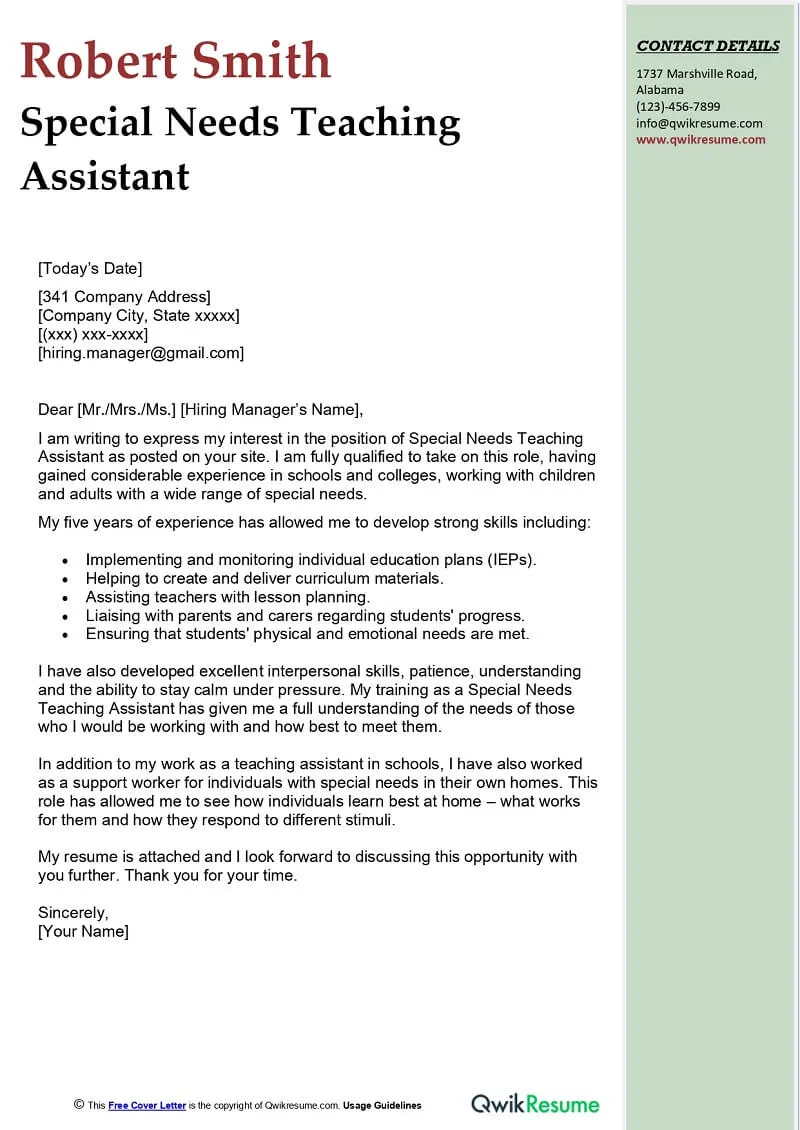
Proper formatting is critical for making a positive impression and ensuring your cover letter is easy to read and understand. Your cover letter should be well-organized, clean, and free of errors. Pay close attention to the following elements to ensure your letter looks professional and polished. It is important to maintain a consistent font style and size, and use clear headings and spacing to break up the text and enhance readability. Proofread your letter carefully to eliminate any typos or grammatical errors. The overall impression you make will be highly impacted by how your cover letter appears.
Header and Contact Information
Start your cover letter with a professional header that includes your full name, address, phone number, and email address. Ensure your email address is professional and appropriate for a job application. Following your contact information, include the date and the hiring manager’s name, title, and the school’s address. If you don’t know the hiring manager’s name, address your letter to the “Hiring Committee” or the appropriate department. This information ensures that the recipient knows how to contact you and also demonstrates your attention to detail.
Salutation and Opening Paragraph
Begin your cover letter with a formal salutation, such as “Dear Mr./Ms./Mx. [Last Name],” if you know the hiring manager’s name. If not, use “Dear Hiring Manager” or “Dear [School Name] Hiring Committee.” The opening paragraph should immediately grab the reader’s attention and express your enthusiasm for the position. State the specific position you are applying for and briefly mention where you saw the job posting. Then, quickly summarize your qualifications and why you are a strong candidate. This initial paragraph sets the tone for the rest of your letter and encourages the reader to continue reading.
Body Paragraphs Crafting a Compelling Narrative
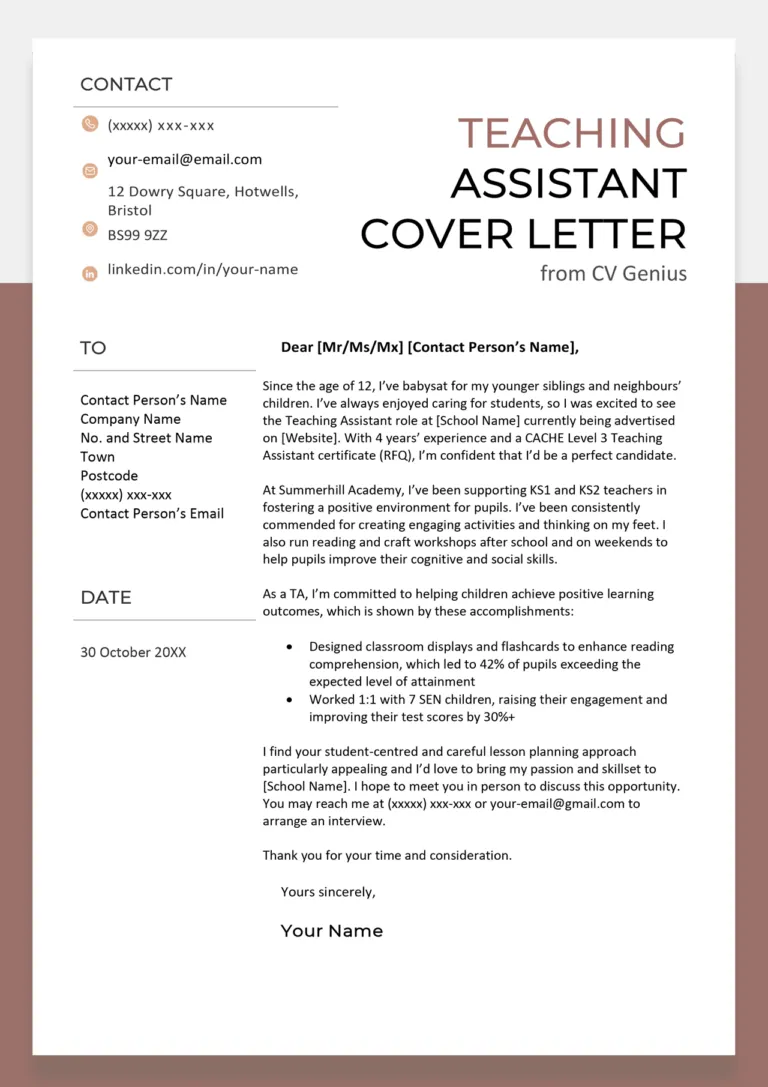
The body paragraphs are where you provide detailed information about your qualifications, experience, and skills. Use two to three paragraphs to expand on your key strengths and accomplishments. Tailor your writing to the specific requirements of the job description and provide concrete examples of how you have demonstrated those skills in the past. Use action verbs to describe your responsibilities and accomplishments. Quantify your achievements whenever possible to showcase the impact you have made in previous roles. Clearly articulate why you are interested in the position and how your skills align with the needs of the school. Remember to keep the tone professional and enthusiastic throughout the body of the letter. The body paragraph should flow smoothly and present a cohesive narrative, making your application stand out.
Emphasizing Your Passion for Education
Demonstrating your passion for education is critical in your cover letter. Assistant teachers often work closely with students and are expected to create a positive learning environment. Express your genuine interest in working with children and helping them learn and grow. Share a personal story or anecdote that illustrates your passion for education or your philosophy of teaching. Show enthusiasm for the specific school or educational institution where you are applying, perhaps by mentioning something you admire about their mission, values, or programs. This shows the hiring manager that you are not only qualified but also genuinely excited about the opportunity to contribute to their educational community. Your passion can set you apart from other candidates.
Tailoring Your Letter to the Specific Role
One of the most important aspects of a successful cover letter is tailoring it to the specific role and school. Avoid sending generic cover letters. Always customize your letter to align with the specific job description and the school’s requirements. Carefully review the job posting and identify the key skills and qualifications the employer is seeking. Use the job description as a guide to highlight the most relevant skills and experiences from your background. Research the school’s mission, values, and any special programs or initiatives. Then, mention specific ways you can contribute to their educational goals. The more personalized your cover letter is, the more likely it is to resonate with the hiring manager and show that you are genuinely interested in the position.
Closing the Cover Letter
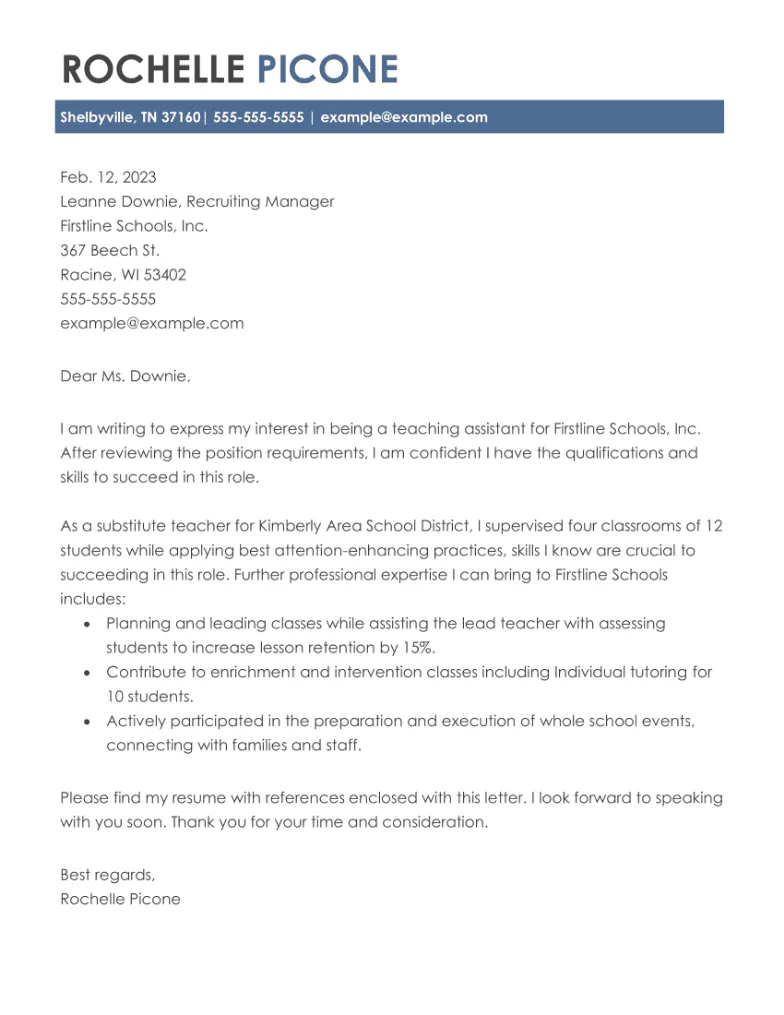
The closing paragraph is your final chance to make a positive impression. Summarize your interest in the position and reiterate your enthusiasm. Clearly state your intention to follow up or how you can be reached. Thank the hiring manager for their time and consideration. Use a professional closing, such as “Sincerely,” “Best regards,” or “Thank you.” Ensure that your contact information is up-to-date and that you are easily reachable for an interview. This final paragraph should leave the hiring manager with a positive impression and a clear understanding of your eagerness for the opportunity.
Expressing Gratitude and Next Steps
In your closing paragraph, express your gratitude for the hiring manager’s time and consideration. Thank them for reviewing your application and for considering you for the position. Indicate that you are eager for the opportunity to discuss your qualifications in more detail. You can also state your intention to follow up on your application. Be specific about how you will follow up. This shows that you are proactive and genuinely interested in the position. Finally, reiterate your enthusiasm for the role and the school.
Proofreading and Finalizing
Before submitting your cover letter, proofread it carefully to eliminate any typos, grammatical errors, or inconsistencies. Errors can undermine your professionalism and make a negative impression on the hiring manager. Use a grammar and spell checker to catch any obvious mistakes. However, always manually review your letter to ensure that the software doesn’t miss anything. Read your letter aloud to catch any awkward phrasing or unclear sentences. Ask a friend, family member, or career counselor to review your letter and provide feedback. A second pair of eyes can often spot errors that you may have missed. Take the time to ensure your cover letter is polished and error-free.
Common Mistakes to Avoid
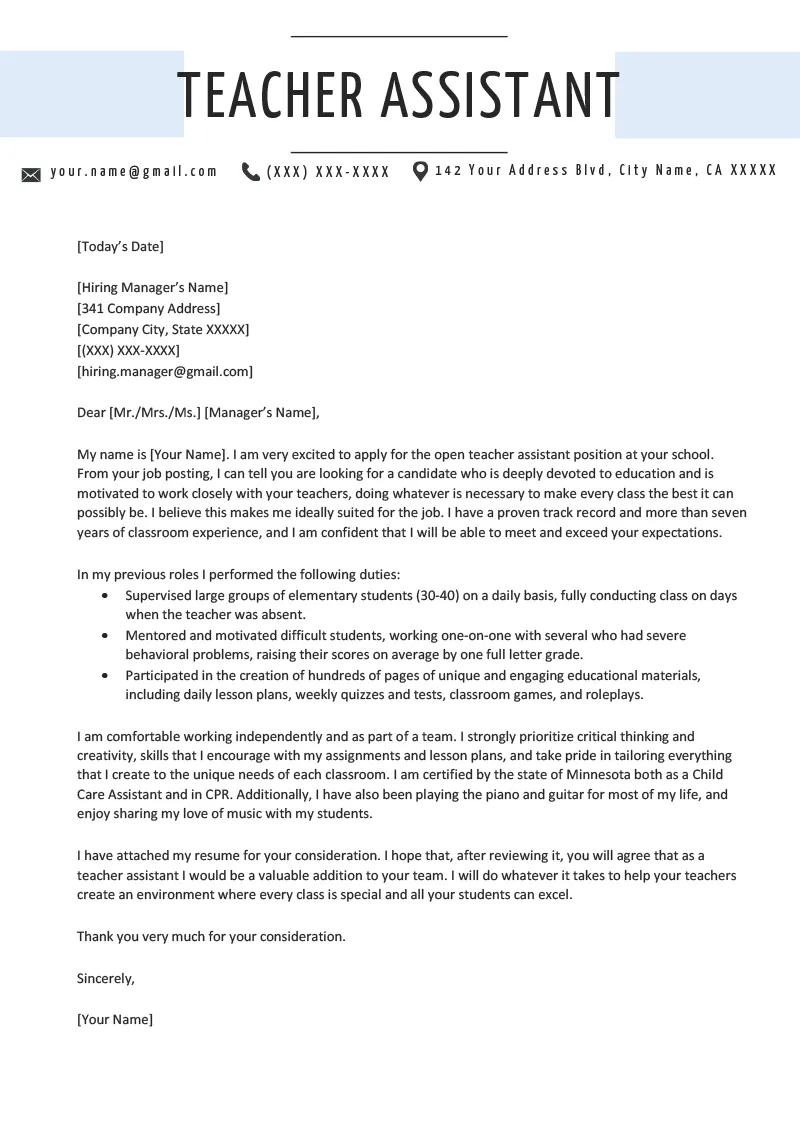
Avoid common mistakes that can hurt your chances of getting an interview. These include using generic language, not tailoring your letter to the specific job, and making grammatical errors. Don’t simply repeat the information in your resume. Use your cover letter to expand on your qualifications and provide specific examples. Do not use clichés or overly casual language. Avoid making negative comments about previous employers or colleagues. Do not exceed the recommended length of one page. Proofread your cover letter carefully, and seek feedback from others to ensure your application is polished and professional. By avoiding these mistakes, you can increase your chances of making a positive first impression.
Ensuring Professionalism and Accuracy
Your cover letter should reflect your professionalism and attention to detail. Maintain a professional tone throughout the document. Use a clear and concise writing style, and avoid slang or informal language. Ensure that all of your information is accurate and up-to-date. Double-check the spelling of the hiring manager’s name and the school’s name and address. Make sure your contact information is correct. Use a professional email address, and consider creating a separate email account specifically for your job search. Your cover letter is a reflection of your overall presentation, so take the time to create a polished and professional document.
